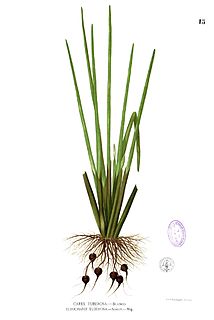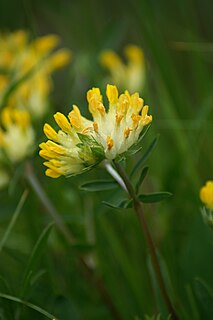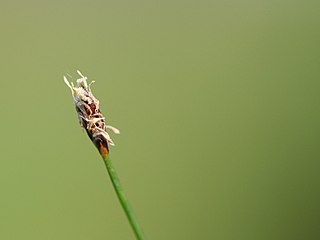
The Cyperaceae are a family of graminoid (grass-like), monocotyledonous flowering plants known as sedges. The family is large, with some 5,500 known species described in about 90 genera, the largest being the "true sedges" genus Carex with over 2,000 species.

Eleocharis dulcis, the Chinese water chestnut or water chestnut, is a grass-like sedge native to Asia, tropical Africa, and Oceania. It is grown in many countries for its edible corms.

Anthyllis is a genus of flowering plants in the legume family Fabaceae. This genus contains both herbaceous and shrubby species and is distributed in Europe, the Middle East and North Africa. The most widespread and familiar species is A. vulneraria, a familiar grassland flower which has also been introduced to New Zealand.

Anthyllis vulneraria, the common kidneyvetch, kidney vetch or woundwort is a medicinal plant native to Europe. The name vulneraria means "wound healer".

Eleocharis is a virtually cosmopolitan genus of 250 or more species of flowering plants in the sedge family, Cyperaceae. The name is derived from the Greek words ἕλειος (heleios), meaning "marsh dweller," and χάρις (charis), meaning "grace." Members of the genus are known commonly as spikerushes or spikesedges. The genus has a geographically cosmopolitan distribution, with centers of diversity in the Amazon Rainforest and adjacent eastern slopes of the South American Andes, northern Australia, eastern North America, California, Southern Africa, and subtropical Asia. The vast majority of Eleocharis species grow in aquatic or mesic habitats from sea level to higher than 5,000 meters in elevation.

Eleocharis acicularis is a species of spikesedge known by the common names needle spikerush and least spikerush. It is widespread across Europe, central and southeastern Asia, North America and northeastern South America as far south as Ecuador. It is also found in Australia, where it is probably an introduced species.
Eleocharis atropurpurea is a species of spikesedge known by the common name purple spikerush. This is an aquatic plant native to much of. It also has a wide distribution in temperate regions of North and South America and Asia. It is present in Europe, where it may be an introduced species for the most part.

Eleocharis macrostachya is a species of spikesedge known by the common name pale spikerush.

Eleocharis quinqueflora is a species of spikesedge known by the common names fewflower spikerush and few-flowered spike-rush. It is widespread across Europe, North Africa, northern Asia, and North America. There are also isolated populations in Argentina and Chile.

Eleocharis palustris, the common spike-rush, creeping spike-rush or marsh spike-rush, is a species of mat-forming perennial flowering plants in the sedge family Cyperaceae. It grows in wetlands in Europe, North Africa, northern and central Asia and North America. Eleocharis palustris is not easily distinguished from other closely related species and is extremely variable worldwide itself. The species epithet palustris is Latin for "of the marsh" and indicates its common habitat.

Eleocharis parvula is a species of spikesedge known by the common names dwarf spikerush, small spikerush and hairgrass in aquaria. It is a plant of brackish and saltwater habitat, such as marshes and mudflats. It is a perennial herb growing tufts of spongy, compressible stems not more than 10 centimeters tall. The plant grows from a tuber which is J-shaped or horseshoe-shaped, a characteristic that helps in the identification of the species. The inflorescence is an oval-shaped spikelet just 2 or 3 millimeters long, made up of several tiny flowers.

Tortula is a genus of mosses in the family Pottiaceae.

Plagiomnium is a genus of mosses in the family Mniaceae. It was formerly a part of a more encompassing genus Mnium and in 1968 Finish bryologist Timo Juhani Koponen justified splitting the genus into a number of smaller genera.
Alchemilla hirsuticaulis is a species of plants belonging to the family Rosaceae.

Eleocharis uniglumis is a species of plant belonging to the family Cyperaceae.
Persicaria foliosa is a species of flowering plant belonging to the family Polygonaceae.
Hieracium crispulum is a species of flowering plant belonging to the family Asteraceae.
Eleocharis fennica is a species of flowering plant belonging to the family Cyperaceae.
Alchemilla propinqua is a species of flowering plant belonging to the family Rosaceae.
Alchemilla glabricaulis is a species of flowering plant belonging to the family Rosaceae.












